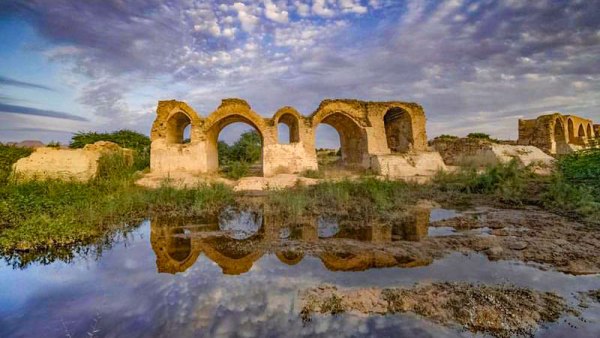
Shadravan bridge
The Band-e Kaisar , Pol-e Kaisar ("Caesar's bridge"), Bridge of Valerian or Shadirwan was an ancient arch bridge in the city of Shushtar, Khuzestan province, Iran, and the first in the country to combine it with a dam. Built by the Sassanids, using Roman prisoners of war as workforce, in the 3rd century AD on Sassanid order, it was also the most eastern example of Roman bridge design and Roman dam, lying deep in Persian territory. Its dual-purpose design exerted a profound influence on Iranian civil engineering and was instrumental in developing Sassanid water management techniques.
The approximately 500 m long overflow dam over the Karun, Iran's most effluent river, was the core structure of the Shushtar Historical Hydraulic System from which the city derived its agricultural productivity, and which has been designated by the UNESCO as Iran's 10th World Heritage Site in 2009.The arched superstructure carried across the important road between Pasargadae and the Sassanid capital Ctesiphon. Many times repaired in the Islamic period, the dam bridge remained in use until the late 19th century.
History
According to Persian tradition, the Band-e Kaisar is named after the Roman emperor Valerian , who was captured with his entire army by the Sassanid ruler Shapur I after having been defeated in the Battle of Edessa . This vast labour force, which may have numbered up to 70,000 men and included the Roman engineering corps, was employed by the victors for construction work in Shushtar, an important agricultural center in south-western Iran. To service its large stretches of arable land, altogether some 150,000 hectares, the Romans set out to construct three structures: a canal called Ab-i Gargar, and the two dams of Band-e Kaisar and Band-e Mizan, which directed the water flow of the Karun river into the artificial watercourse.
The story is related by the Muslim historians Tabari and Masudi in the 9th and 10th centuries. Although their novelistic narrative cannot be blindly trusted, the historical presence of the Romans is corroborated by modern local names, such as "Roumischgan" for a nearby village, and a Lurs tribe by the name of "Rumian". Moreover, local tradition ascribes to Roman settlers the origin of a number of trades, like the production of brocade, and several popular customs.
The dam bridge at Shushtar belonged to the important road connection between the Sassanid centres of Pasargadae and Ctesiphon. Two further Sassanid dam bridges on this road, the Pa-i-Pol across the Karkheh and the one at Dezful over the Ab-i Diz, are also assumed to be the contemporary work of Roman prisoners of war. Both exhibit typically Roman masonry bound with mortar, a technique completely foreign to indigenous architecture.
Modelled on the Roman example, the integration of a bridge superstructure into dam design became a standard practice of Iranian hydraulic engineering which lasted until about 1000 AD, when it culminated in the still existing Band-e Amir at Shiraz.

